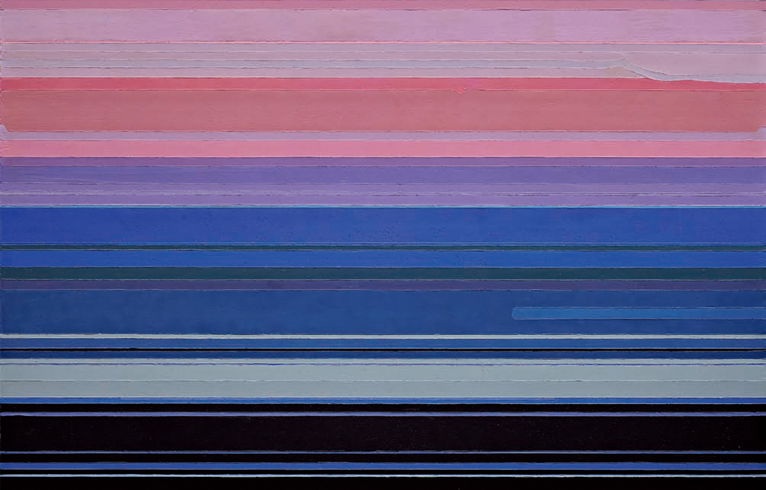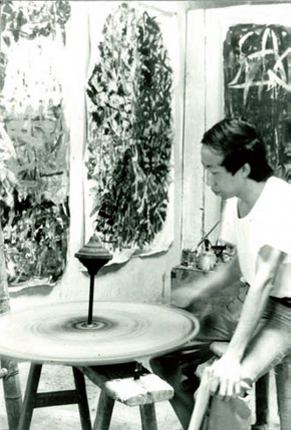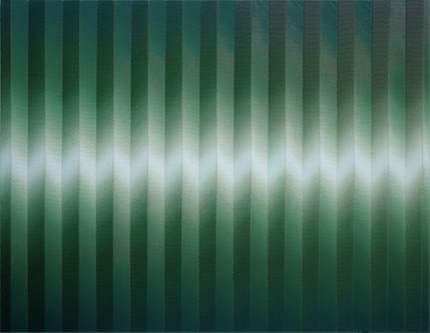Farewell to an Idea: Abstract Art
| January 2, 2012 | Post In LEAP 12

Under the present conditions in China, if a more thorough analysis of the concept of abstraction is not carried out, then it will gain a kind of cognitive inertia and mutate into a new popular symbol. In fact, we are already witnessing this risk, particularly in this moment of large-scale marketing in the art world…
AFTER THE JANUARY 1983 issue of Meishu magazine came out, Li Xianting, the editor responsible for that issue, was suspended. The government had initiated the Anti-Spiritual Pollution campaign, and Li had brought about his own downfall by putting together a special section on abstract art. This section, titled “A Study of the ‘Abstract’ Issue in Fine Arts,” included— in addition to a handful of long-forgotten theoretical essays— a highly memorable back cover, as well as works by Wu Guanzhong (inside front cover), Wang Keping (inside back cover), Huang Yong Ping, Qu Leilei, Huang Rui and others. There was also an artist statement by Huang Yong Ping. (Providing a sharp contrast, the issue also featured examples of Rustic Realist painting— then at its height— by way of artists such as Luo Zhongli, Ai Xuan, and He Duoling.)
In retrospect, it does not seem entirely accurate to describe the work of these artists as abstract art. To say that these works all reflected abstract beauty— a very Chinese concept— would be closer to the truth. Abstract beauty was also a focal point of Li Xianting’s special section. The theoretical essays were in consensus in emphasizing the abstract elements of traditional Chinese art in order to affirm the contemporary legitimacy of abstract beauty. In fact, the discussion of abstraction in mainland China in the early 1980s began with Wu Guanzhong’s 1980 essay titled “On Abstract Beauty.” As Wu saw it, “abstract beauty is the core of formal beauty.” In other words, at the time, the debate about abstraction was no more than a component of the debate about formal beauty. Meanwhile, the concepts of “formal beauty” and “abstract beauty” relied on an objective premise of beauty. In China in the early 1980s, people relied on these ostensibly modernist concepts to express what were in fact Enlightenment ideals. Aesthetic education was an important tool for the realization of Enlightenment values, and here, “beauty” was the beauty of “truth, goodness, and beauty.” At this level, the discussion of abstraction and beauty in form belonged to the same cultural logic as Rustic Realism and Scar Art; they all shared the common origins of reflection on and rebellion against Cultural Revolution art and Socialist Realism, as well as the post-Cultural Revolution recovery and dissemination of humanist discourse.

So there was little understanding of the history of Western modern art and the abstract movements in that history— Cubism, Futurism, De Stijl, Suprematism, Constructivism, Abstract Expressionism, Post-Painterly Abstraction, Color Field Painting, Minimalism and Optical Art— were all hastily swept into the simple concept of abstract beauty. The specific and complex art-historical contexts of these movements, and particularly the background of abstract art in Western Rationalism and Transcendentalism, were discarded. Objectively speaking, this simpler version of abstraction was easier to adapt to the quest for beauty in the new era of humanist discourse. Interestingly, nearly all of the abstract works in that 1983 issue of Meishu were the kind of painting that features a pure form extracted from nature. Huang Yong Ping was the only exception. His piece was a steel plate sprayed with car paint, and it seemed to be the result of a deliberate effort to avoid the then-popular humanist discourse, including aestheticism and the subjectivity of the artist. This effort was manifest in the respect in his work for tools, media and material: “Tools here are not simply tools. They have been shifted toward their own initiative. Whether it is the visualization of the picture plane or even the achievement of the ultimate result, my work looks to the tools for inspiration and submits to them rather than imposing upon them.” This statement uniquely demonstrates a modernist understanding of media, but Huang soon shifted toward a complete repudiation of modernism. His focus was on deriving methods through tools, and in 1985 he began using spinning wheels to create “non-expressive paintings,” employing Dadaist methods to fully abandon the romanticization of artistic subjectivity. As subjectivity was extolled and a new Enlightenment was proclaimed in the 1980s, Huang’s ideas and practices were undoubtedly exceptional. Many allegedly abstract practices that came later were in fact similar to Huang’s work.
First of all, there was Ding Yi, whose “Appearance of Crosses” series, begun in the late 1980s, employed repeated the symbols “+” and “x.” These two symbols, which seem like a printer’s calibration lines, are alleged to have been inspired by Ding’s experiences working at a print shop, but in their continuous repetition, their connotations of general significance and individual experience are exhausted, leaving only their material form. The observer sees only the closely crowded, indifferent brush strokes, as well as the textures of various media and materials. Although there is color, it originates in the principle of “automatic color selection,” by which the aesthetics and individuality of colors are eliminated through the use of a limited selection of colors— or, more accurately, pigments. Ding Yi applied these specially formulated methods to compressing the significance of his works into a layer of pigments on a piece of cloth, their accumulated quantity, and the hours of time consumed in their production. This approach does not stop observers from treating his works as aesthetic and interpretable objects, but Ding’s starting point shows that he did his utmost to discourage his works from referring to any psychological or social significance. He states his case clearly: “I hope people can come together around the color, line and structure of painting, rather than the significance that the picture plane implies. As soon as people look past so-called significance, they become more open to the new feelings that art brings.”
A comparison of the ostensibly abstract artistic practices of Huang Yong Ping and Ding Yi with Western (and particularly, European) modernist abstraction reveals that their cultural backgrounds are completely different. There was always a transcendental concept underlying European abstraction: that is, the legitimacy and necessity of abstract form sprang from being able to bypass reproducible media and directly access the transcendental content itself. This transcendental content included diverse subjects such as style, personality, talent, God, ideas, and the theory of historical progress. In contrast, the abstraction practiced by Huang and Ding contain no trace of such content and sought even to reject it. They negate subjectivity, personality, aesthetics, and even art, as demonstrated by Huang’s explicit appeal to Dadaism. In other words, the art practices of Huang and Ding in no way encompass the concept of abstraction. They do not seek to initiate any aesthetic activity, let alone abstract beauty, nor do they express any personal or a priori spiritual content. The formal results of their work are revealed in technique, method, concept and attitude; these works, above all, are inescapably material. Now let us more specifically address the history of contemporary Chinese art and its underlying ideas. During the humanist trend of thought that emerged in the late 1970s and crested in the early 1980s, and during the modernist wave of 1985, artists drew on the Western art-historical concept of abstraction in hopes of establishing a certain degree of formal and artistic autonomy— principles of modernity. However, the reconsideration, revision and repudiation of those same principles of modernity constituted another important element of Chinese contemporary art. This alternative trend provides the context in which the significance of the work of artists such as Huang Yong Ping, Wu Shanzhuan, the Pond Society, and the New Analysts can be ascertained. Thus we can distinguish between two different kinds of abstraction: the first, a humanist, modernist abstraction, rooted in the quest for formal beauty of the early 1980s; and the second, a contemporary— or perhaps anti-modernist— abstraction possessing a negative quality, which emerged from the rethinking and repudiation of humanism and modernism. These two kinds of abstraction were far more different than alike, even to the point that the latter, exemplified by Ding Yi’s “Appearance of Crosses,” was more akin to Zhang Peili’s “X?” series of rubber gloves: both were inspired by a resistance to and weariness of superfluous significance.

In other words, the seemingly abstract works of Huang Yong Ping, Ding Yi, and later, Yan Lei, Liu Wei, Wang Guangle, Liu Wentao, Li Shurui, Xie Molin, Zhan Rui, and others, should perhaps not be called abstract art. In fact, applying the concept of abstraction can be an obstacle to understanding key aspects of the practices of these artists. On this subject, one example worthy of discussion is Meng Luding. He began with symbolism and expressionism but then turned to modernist abstraction before ultimately surpassing modernist abstract artists. His frequent changes of impetus were the result of repeated reconceptualizations of artistic ideas. Meng turned to abstraction in the late 1980s in order to emphasize the importance of the thing-in-itself, demonstrated by the materials and structure of his “Yuan Tai” series. In contrast, he used machines to paint his recent “Yuan Su” series, a concept and method that itself becomes an artistic noumenon. This sort of work falls under the category of negative abstraction, but in fact, there is no need to apply the abstract label to these works in the first place.
In reality, the term “abstract” is not neutral. As J. L. Austin posits, language possesses performativity, and it is always producing the reality it describes. Under the present conditions in China, the concept of abstraction in fact encourages its appliers to appraise only the material results of the different artistic practices to which it is applied, overlooking the underlying ideas, thoughts, methods, and techniques. Therefore, if a more thorough analysis of the concept of abstraction is not carried out, then it will attain a kind of cognitive inertia and mutate into a new popular symbol. In fact, we are already witnessing this kind of risk, particularly in this moment of large-scale marketing in the art world.
There is also a variety of theoretical advertising worthy of our skepticism: namely, the positioning of this anti-modernist abstraction as a kind of Chinese or Eastern abstraction in which Western reconsiderations of the theories of modernism and the Enlightenment are simplistically equated with Buddhism and Daoism, and the internal repudiations of those Western concepts, which admittedly draw on non-Western discourses, are seen as a complete shift to the so-called East. Ironically, the theorists of the early 1980s defended the quest for aesthetic beauty and its universalist underpinnings by claiming, in essence, that “it has always been so”; but today, the same claim is invoked to promote this anti-modernist abstraction and its underlying localism.
In times in which paintings are loaded with social symbolism and vulgar sociological criticism runs rampant, using abstraction to emphasize the importance of medium and noumenon is all well and good. But it is not any more meaningful to use the veneer of abstract form as a standard for categorizing art, nor is it is necessary to take the concept of abstraction as a polestar— as in, “post-abstract”— for art history has not dwelt with such emphasis on this concept, and in fact has long since outgrown it. Should the art market not follow suit?


